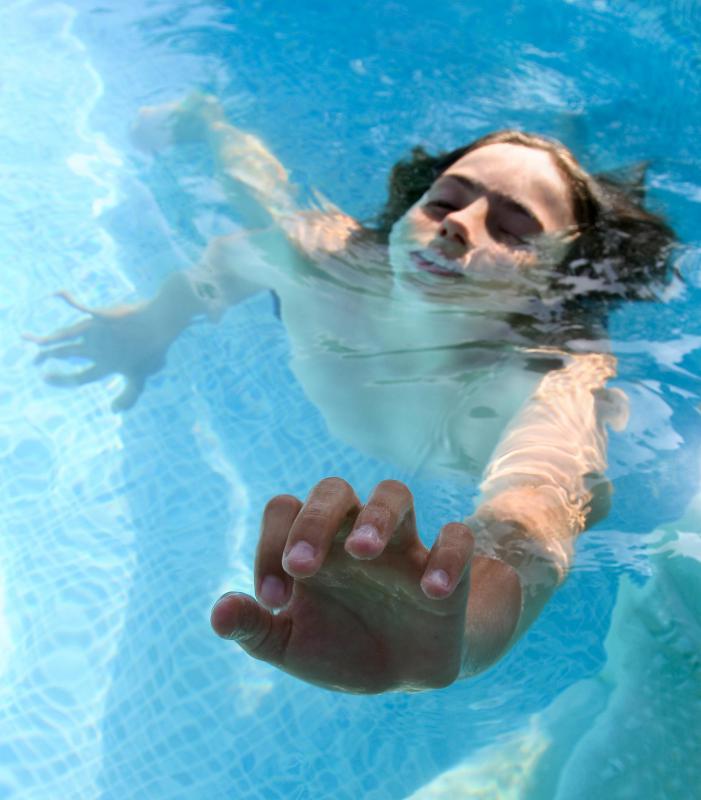At HomeQuestionsAnswered, we're committed to delivering accurate, trustworthy information. Our expert-authored content is rigorously fact-checked and sourced from credible authorities. Discover how we uphold the highest standards in providing you with reliable knowledge.
What is a Pool Alarm?
A pool alarm is a device that sounds a loud alert if a small child or pet should fall into the backyard pool or approach its perimeter. Pool alarms are intended to augment other safety measures such as perimeter fences and supervision, and should not be relied on as the sole means of pool safety. They can, however, play a key role in protecting lives when other measures have failed. There are four main categories of pool alarms: above ground, floating, submerged, and wristband alarms.
In the above ground category, there are different grades of pool alarms. One type uses infrared or lasers to surround the pool with an unbroken beam of invisible light. The beam can be set to a specific height, for example, one to two feet (about 300-600 mm), depending on the height of your smallest child or pet. Once the pool alarm is armed, if the beam is broken, an audible wail sounds.

The advantage to this type of pool alarm is that it signals danger prior to a child or pet entering the water. Disadvantages are that it can give false alarms if moved by windy conditions, accidentally hit, blocked, or if inanimate objects roll or blow through the beam. Also, if a beam is set too high a small toddler such as a neighbor's child might crawl beneath it. If set too low, an older child can step over the beam.

A more secure above ground pool alarm is a sentry-type alarm. This type of pool alarm combines a motion detector with a heat sensor. Rather than a thin beam surrounding the pool at a set height, this pool alarm covers a wide swathe of area, up to 150-degrees or more. Inanimate objects that do not have a heat signature cannot trip this type of pool alarm, and there is no worry about a beam being set too high or low.
While above ground alarms can be very effective, some people prefer a pool alarm that sits in the pool itself. In this category, there are floating pool alarms and submerged pool alarms.

A floating pool alarm can be tied off to the pool ladder and left to bob on the surface of the water. If a child or pet falls into the pool, subsequent surface waves will cause the pool alarm to sound. Floating alarms can be set for sensitivity to avoid false alarms for small waves created by wind.
A submerged pool alarm is a 90-degree angled device that sits on the edge of the pool with one downward arm submerged into the water. This type of pool alarm reads water displacement or underwater waves, and has fewer false alarms than a floating pool alarm. It can also be used with a pool cover. One disadvantage of a submerged or floating pool alarm is that it can be removed from the pool. Additionally, these alarms might not detect children or pets less than 15 pounds (6.8 kg), unless otherwise stated.

Finally, a wristband pool alarm is a key-locked device that is worn on the wrist of a child, or it can be secured to the collar of a pet. The device is linked to a base unit, kept in the house. If the wristband gets wet, an alarm immediately sounds from the base unit. Several wristbands can be linked to a single base unit, and extra wristbands can be purchased for visiting children. Wrist alarms can also be used on boats, but are not intended for salt water.
Disadvantages of this type of alarm are that it cannot protect children that might wander into the yard. It will also sound if a child is washing his or her hands and gets the device wet, is playing in the sprinklers, using the hose, etcetera.
The pool alarms discussed in this article are generally in the 200-300 US Dollar (USD) range. While this might sound pricey at first glance, they can literally save lives. The U.S. Consumer Product Safety Commission (CPSC) reports about 350 pool drownings per year in the United States of children under the age of five. Approximately 2,600 more children are hospitalized, according to CPSC statistics.
If you don't have children yourself, a pool alarm can protect the lives of neighborhood children. Some pool alarms come with handouts to inform neighbors that you have installed a pool alarm, and they should respond if they hear an alert. The CPSC reminds pool owners that pool barriers and supervision are the best defenses against accidents, with pool alarms being an additional safeguard.
AS FEATURED ON:
AS FEATURED ON:














Discussion Comments
First of all you will have to consider having an alarm system. This is because you will need to get a form of protection whenever you are absent. The great news is that there is a great variety of alarms that are available. In truth, alarm systems can be separated in two broad categories: wired and wireless systems. It will all depend on your needs and budget.
Post your comments